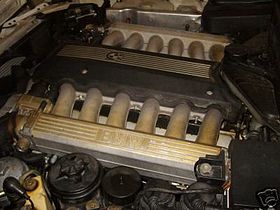BMW M70
| BMW M70 engine | |
|---|---|
 | |
| Overview | |
| Manufacturer | BMW |
| Production | 1988–1996 |
| Layout | |
| Configuration | 60° V12 |
| Chronology | |
| Predecessor | None |
| Successor | BMW M73 |
The BMW M70 is a V12 SOHC piston engine which was BMW's first production V12[1] and was produced from 1988-1996.
Design
The M70 was essentially derived from two M20 straight-6 engines joined at a 60 degree angle.,[2] however the two engines share very few cross compatible parts. The engine has the same bore and stroke on each bank as the M20,[3] also the M70 has two Motronic ECUs (one for each cylinder bank).[4] This said, the M70 engine does differ from the M20 engine in a number of key ways, including but not limited to:
- AluSil block, in place of the cast-iron used in the M20.
- Mass Airflow Meters (MAF) are used instead of the more dated Air Flow Meter (AFM) design. The former is a more straight through design, similar to those employed in later BMW engines such as the I6 M50, M52, and V8 M60, M62 etc. This gives a more responsive and accurate measurement than the older AFM style, aiding fuel economy
- Electronic Throttle Control is used in most markets instead of the cable setup common in other BMW engines until the later 1990s. For the most part this was surprisingly reliable system despite its complexity, particularly for the time. However issues with the DK throttle bodies is well documented
- Hydraulic valve lifters are also used, similar if not the same as those used in the BMW M40 and M50 and later engines, rather than the mechanically adjusted tappets used in earlier engines including the M20. This was primarily due to ease of servicing. The M20 engines require tappets to be adjusted every 30,000 miles (50,000km). However due to the dual crossover banks on the M70, this would require removal of the intake manifolds to service.
- Minimal parts are interchangeable between the M20 and M70 engines. Spark plugs, leads for the right bank, air filter (but not air box), and the late style front mount M20 distributors and rotors are all cross compatible with M70 engines, however virtually everything else is M70 V12 specific.
Some examples of this engine are fitted with two alternators, such as in the E32 750iL Highline. One alternator is a full sized unit to service the car as on "regular" V12 models (regular to be taken in context of course), while the secondary smaller unit is used to charge an auxiliary battery and power all options in the rear passenger compartment, such as telephones and fax machines, as well as the wine cooler, independent climate control and power sun shields.
The compression ratio is 8.8:1, stroke is 75 mm (3.0 in) and bore is 84 mm (3.3 in).[5]
Models
| Engine | Displacement | Power | Torque | Redline | Year |
|---|---|---|---|---|---|
| M70B50 | 4,988 cc (304 cu in) | 220 kW (300 hp) @ 5200 | 450 N⋅m (330 lb⋅ft) @ 4100 | 6000 | 1988 |
| S70B56 | 5,576 cc (340 cu in) | 280 kW (380 hp) @ 5300 | 550 N⋅m (410 lb⋅ft) @ 4000 | 1992 | |
| S70/2 | 6,064 cc (370 cu in) | 461 kW (618 hp) @ 7400 | 650 N⋅m (480 lb⋅ft) @ 6700 | 7500 | 1992 |
| S70/3 | 5,990 cc (366 cu in) | 448 kW (601 hp) @ 7500 | 651 N⋅m (480 lb⋅ft) @ 5600 | 7500 | 1997 |
M70B50
Applications:
- 1987–1994 E32 750i/750iL - this was mated exclusively an automatic ZF 4HP24 transmission
- 1989–1994 E31 850i/850Ci - this was mated to either the automatic ZF 4HP24 transmission or the optional Getrag 560G
S70
The S70 was an enlarged version of the M70 fitted to the performance flagship models, as well as dedicated performance cars. There were two production generations
S70B56
This is a 5,576 cc (340 cu in) variant of the M70 engine.[6] With 1,510 units produced, this is the lowest production BMW engine to date.[7]
Applications:
- 1992–1996 E31 850CSi
S70/2
Among the improvements over the other M70/S70 engines, the S70/2 features 4 valves per cylinder and variable valve timing (called dual-VANOS by BMW).[8]
Applications:
- 1993–1998 McLaren F1
- 1998–1999 BMW V12 LM
- 1999–2000 BMW V12 LMR
References
- ^ http://www.usautoparts.net/bmw/models/e32.htm
- ^ http://autospeed.com.au/cms/title_2004-Engine-Epic-BMW-Engines/A_2107/article.html
- ^ http://www.carfolio.com/specifications/models/car/?car=14322
- ^ http://www.wokke.de/Chiptuning/Chip_Installation.htm
- ^ http://www.carfolio.com/specifications/models/car/?car=14322
- ^ http://www.bmwheaven.com/database/engine.php?type=Motorsport#/167
- ^ http://www.8coupe.com/Production/WorldwideShipments/S70850CSi19921996.aspx
- ^ http://www.audiosignal.co.uk/McLarenF1.html
External links
- http://bmwe32.masscom.net Johan & Sean's E32 Page - Homepage containing detailed DIY and engine rebuild information for the M70 engine as well as links to official BMW AG engine specs and component descriptions.
- http://www.audiosignal.co.uk/McLarenF1.html Information on McLaren F1 engine
- The UnixNerd's BMW M70 engine page with photos, history and common problems.
- The UnixNerd's BMW S70 engine page with details of the S70 5.6 and S70/2 for McLaren F1.
